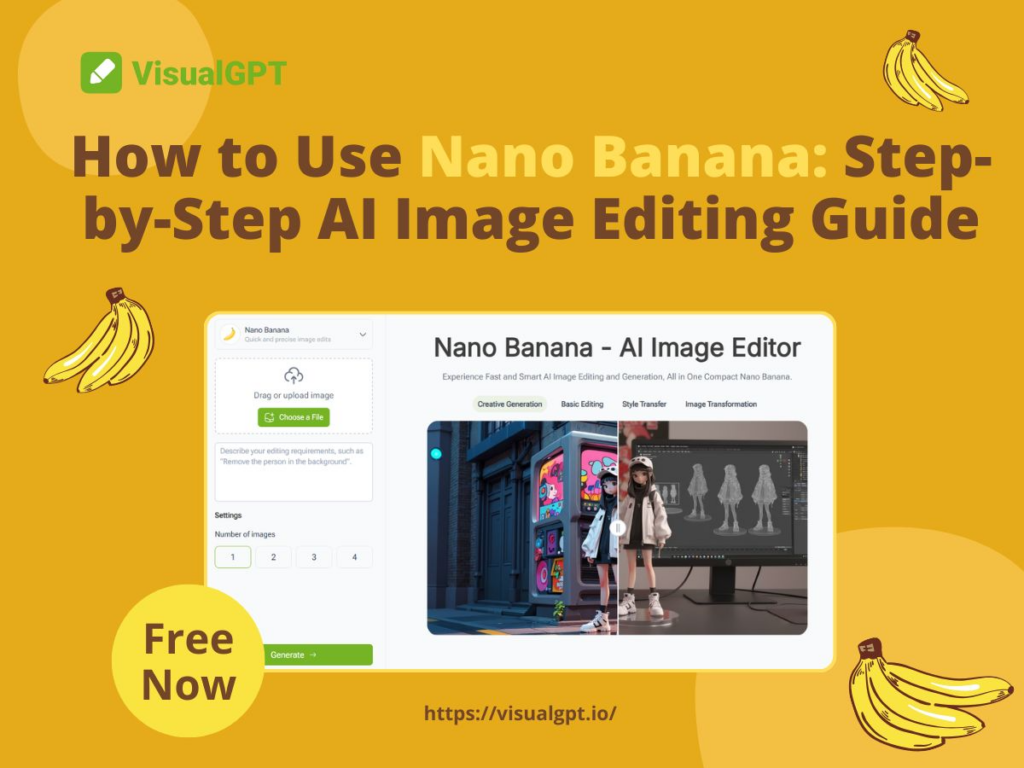The Mysterious Arrival of Google’s AI Model
In late 2024 and early 2025, AI researchers noticed a new model performing extremely well in LMArena, a testing ground where different AI models compete without revealing their names. One of the anonymous models, code-named Nano Banana, stood out. It could edit photos with incredible consistency, maintain style across multiple edits, and even combine complex visual concepts with ease, which quickly made users curious about how to use nano banana in their own projects.
When Google finally revealed that Nano Banana ( gemini-2.5-flash-image-preview ) was their creation, the AI community buzzed with excitement. By 2025, it had already been integrated into the Gemini ecosystem, and through partnerships with platforms like VisualGPT, it became available to a wider audience eager to learn how to use nano banana for real-world applications.
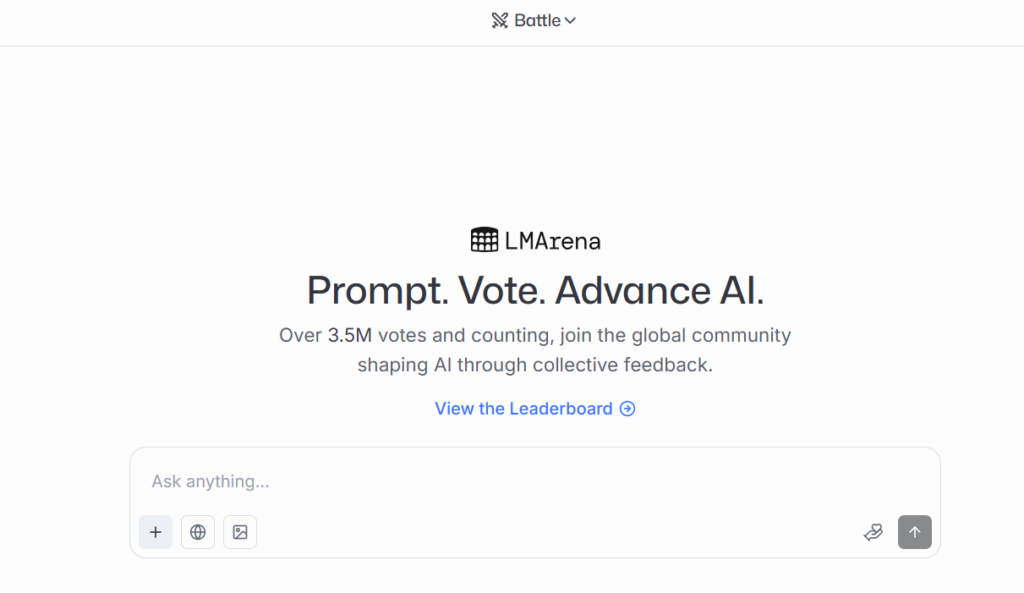
What Is Nano Banana?
Background and Development
Nano Banana is an internal codename for Google’s advanced AI image editing and generation model. It builds on the Gemini 2.5 Flash architecture, which is designed to be fast, efficient, and reliable. Unlike many AI image generators, Nano Banana was specifically optimized for consistency (keeping details intact) and controllability (making precise edits).
Core Advantages of Nano Banana
Local Edits Without Distortion One of the biggest frustrations with older AI editing tools is that a small change often impacts the entire image. With Nano Banana, this issue is solved. For example, if you upload a portrait and only want to change the color of the jacket, the model keeps your face, hairstyle, and background completely intact. This makes edits look natural and professional. Many users who first learn how to use nano banana quickly realize that this precision is what sets it apart from traditional generators.
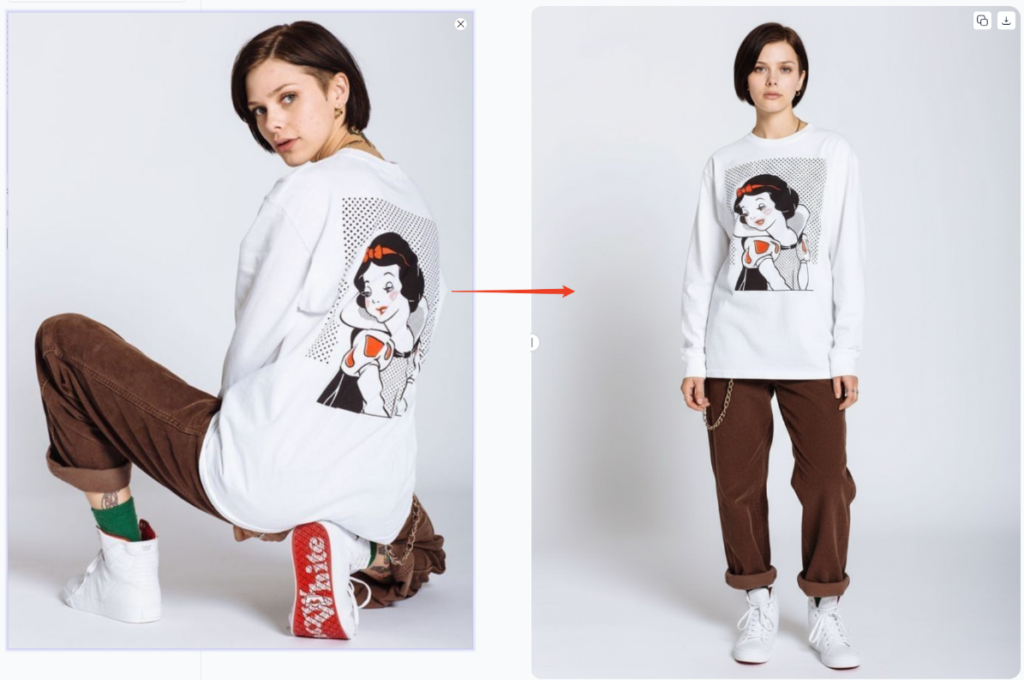
Style Flexibility Nano Banana is not limited to realistic edits—it can also apply creative styles without breaking the harmony of the image. Imagine turning a city street photo into a glowing cyberpunk scene, or transforming a classroom picture into a watercolor painting, while still preserving the original objects and people. If you’re exploring how to use nano banana for artistic projects, this flexibility gives you a huge creative advantage.
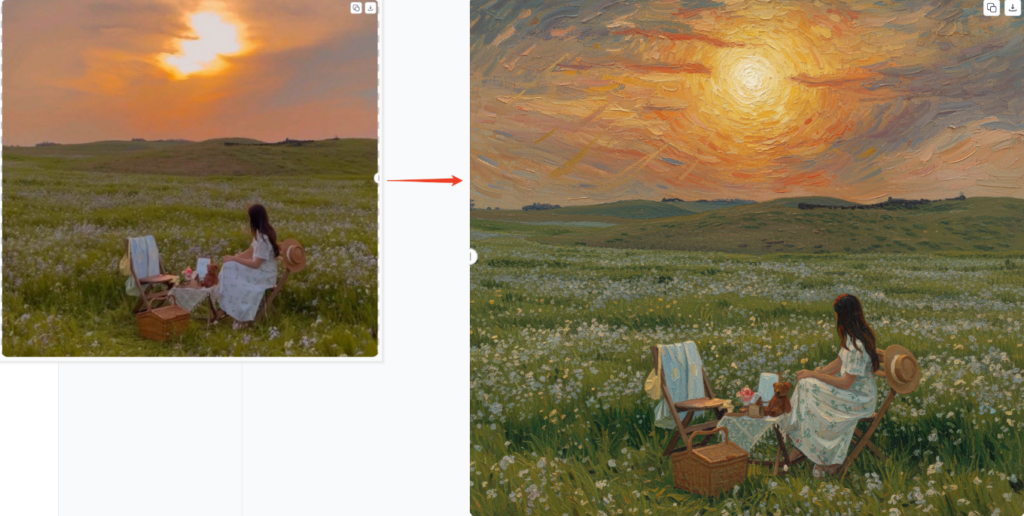
Dialogue-Based Editing Unlike models that force you to craft a perfect, one-shot prompt, Nano Banana allows you to work step by step. You can say, “Add a coffee cup on the table,” then follow up with, “Make the lighting softer,” and finally, “Change the wall color to light gray.” It feels like giving instructions to a designer rather than struggling with prompt engineering. For anyone curious about how to use nano banana in a more interactive way, this conversational editing is one of the most powerful features.
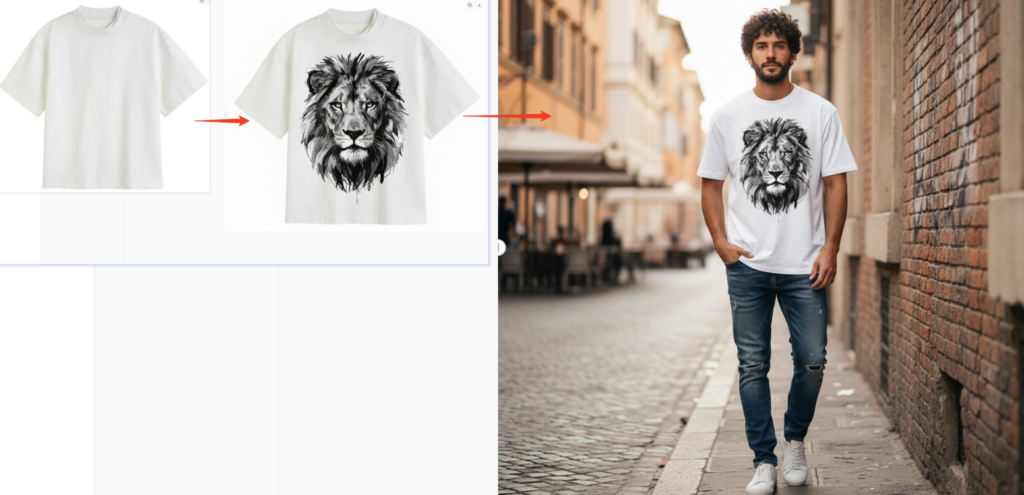
High Accuracy Nano Banana’s ability to understand prompts is another core strength. It pays attention to details like “a navy blue jacket with silver buttons” instead of just producing a random blue coat. This accuracy saves you time and reduces the trial-and-error process common in other AI editors. Once you start practicing how to use nano banana, you’ll notice how quickly it responds to even complex instructions with results that match your vision.
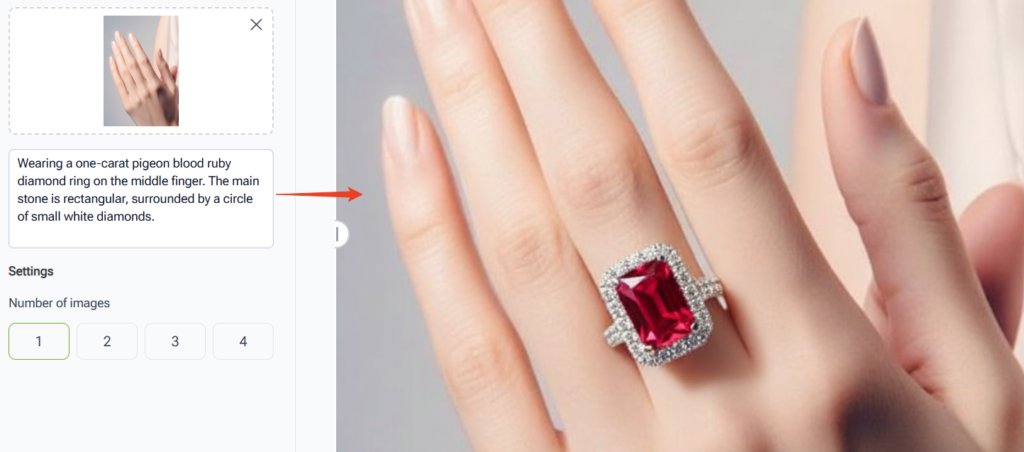
Nano Banana vs Other AI Image Editing Tools
When people ask how to use nano banana, they often want to know how it stacks up against other tools. Each AI model has unique strengths, but Nano Banana stands out for combining precise editing with creative flexibility. Below is a detailed comparison.
| Tool | Strengths | Weaknesses | Example |
| Midjourney | Artistic, creative styles | Weak in edits, no uploads | Fantasy art scene |
| DALL·E 3 | Great text-to-image | Style shifts in edits | Class cartoons |
| Stable Diffusion | Open-source, customizable | Complex setup | Anime generator |
| Adobe Firefly | Strong Adobe integration | Slow, limited outside Adobe | Marketing banners |
| Runway Gen-2 | Good for video & storytelling | Weak for photos | Storyboard films |
| Nano Banana | Accurate, consistent, easy edits | Fewer tutorials (new) | Selfie → café edit |
Nano Banana vs Other AI Image Editing Tools
Key Features of Nano Banana
Uploading and Editing Images
You can start by uploading your own photos, product shots, or even sketches. Nano Banana analyzes the content and gets ready for precise editing.
Using Text Commands for Image Generation
Type simple instructions like:
- “Change the shirt color to red.”
- “Turn this street into a rainy cyberpunk scene.”
- “Add a forest background behind the person.”
Nano Banana responds naturally to these commands, often in seconds.
Overlay Options and Batch Editing
Need multiple variations? You can ask Nano Banana to create several versions at once. For product photos, you can generate the same item in different colors, backgrounds, or lighting—all in one session.
How to Access Nano Banana for Free
Is Nano Banana Free to Use?
The official pricing of Nano Banana is about 1290 tokens per image, which equals roughly USD $0.039 per image. This makes it very cost-effective compared to most AI image generators.
At the same time, you can also use Nano Banana for free on VisualGPT, making it easy for beginners to explore how to use nano banana without worrying about cost. Free access is great for testing small projects, while the official low pricing is ideal for creators who need larger batches of high-quality edits.
Platforms Where You Can Try Nano Banana
Gemini API
The Gemini API gives developers direct access to Google’s Gemini model with stable performance and flexible integration. It’s powerful for those who want full control over how to use nano banana in their own apps. However, it requires programming knowledge, and costs can rise as usage scales, making it less beginner-friendly.
Google AI Studio
Google AI Studio is a web-based option that requires no setup. With official Google support, it’s great for quick testing and demos when learning how to use nano banana. The downside is that free credits are limited, it lacks advanced settings compared to the API, and it’s not ideal for larger projects.
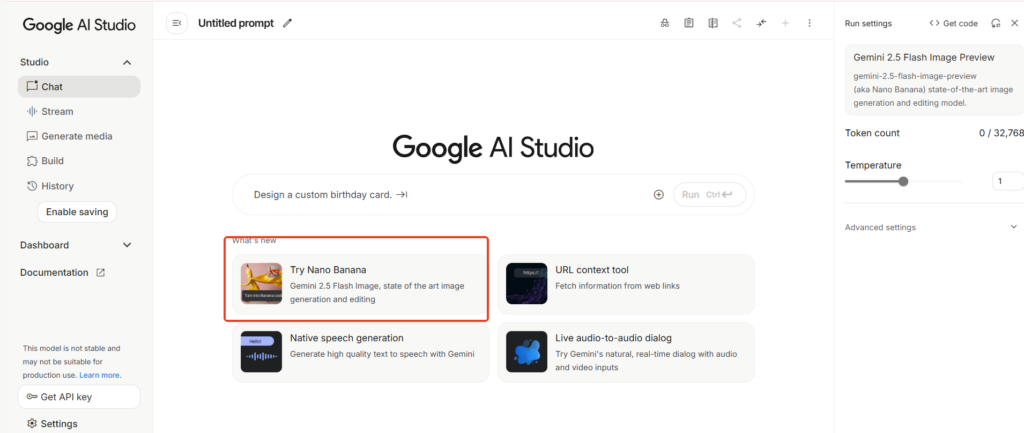
Vertex AI
Vertex AI is designed for enterprise users who need scalable infrastructure and smooth integration with Google Cloud tools. It’s well-suited for professional workflows where learning how to use nano banana is part of a bigger system. But setup is more complex, cloud expertise is required, and costs can rise quickly with heavy usage.
LMArena
LMArena is a community-driven platform built for benchmarking and comparing AI models. It’s especially useful for side-by-side testing to explore how to use nano banana alongside other tools. Still, it is focused on testing rather than production, so stability for creative projects may be limited.
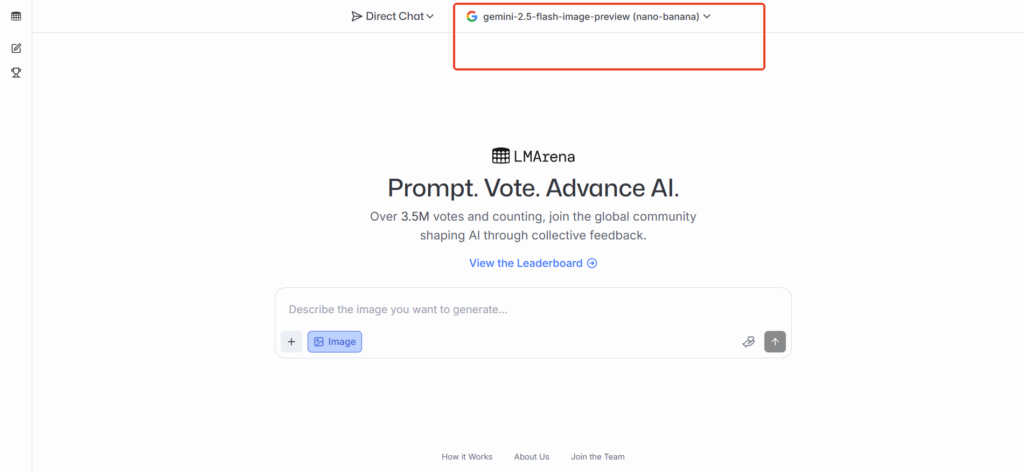
VisualGPT
VisualGPT offers the simplest way to start. You can use Nano Banana instantly for free, with no login required, and the interface is very beginner-friendly for step-by-step learning on how to use nano banana. The limitation is that it lacks enterprise features and is better suited for individuals or small teams.
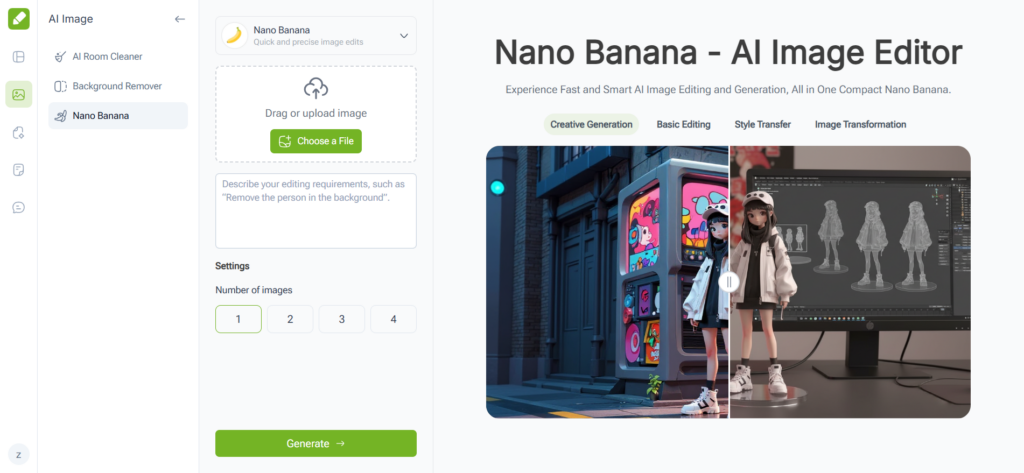
Using VisualGPT’s Nano Banana Model Without Login
Platforms like VisualGPT give you a simple interface: upload an image, type a command, and get instant results. No registration or payment walls make it perfect for casual creators, students, and anyone exploring how to use Nano Banana for the first time.
Step-by-Step Tutorial: How to Use Nano Banana
Here’s a beginner-friendly walkthrough:
Step 1 – Upload or Start with a Blank Canvas
Open VisualGPT and select Nano Banana. Upload your image, or begin with a blank canvas if you want to generate from scratch.
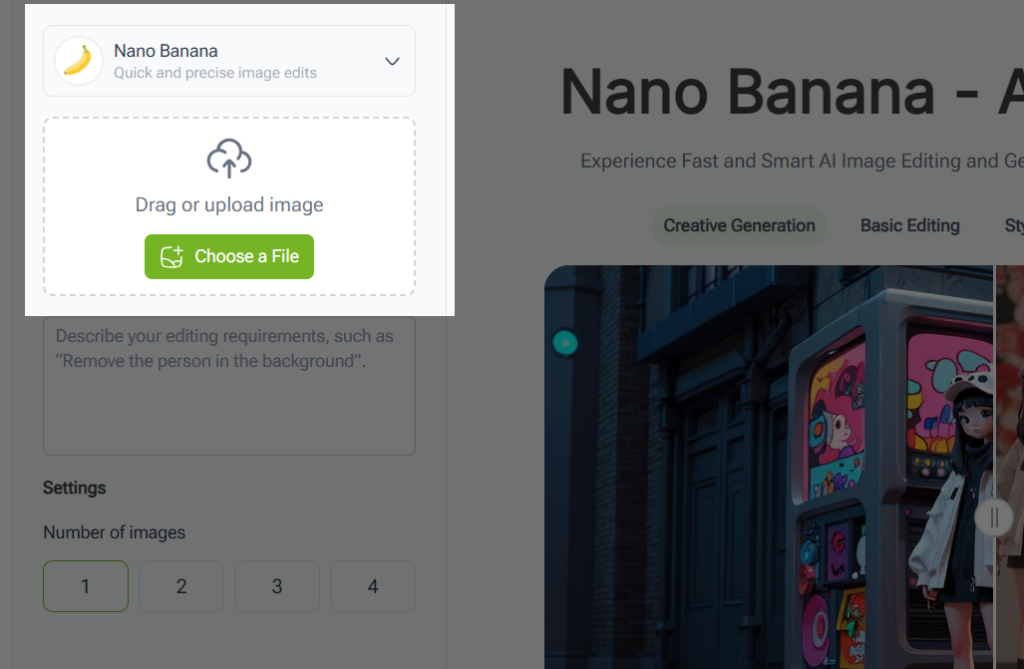
Step 2 – Enter and Refine Text Prompts
Type a clear command, like:
- “Make this jacket blue.”
- “Replace the background with a coffee shop.”
If the result isn’t perfect, refine your instructions. Nano Banana supports multi-turn conversations, so you can keep adjusting.
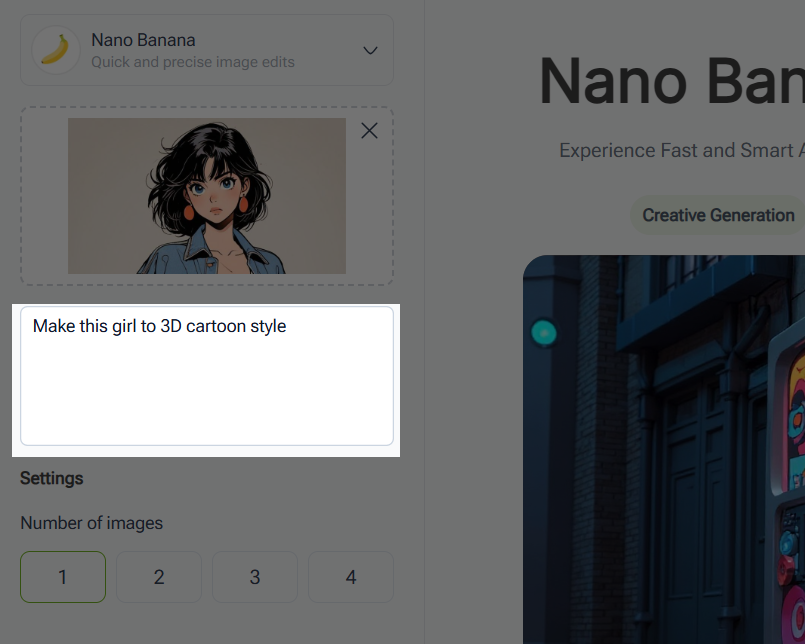
Step 3– Generate and Preview Images
Click “Generate” and wait a few seconds. You’ll get a preview with different variations to choose from.
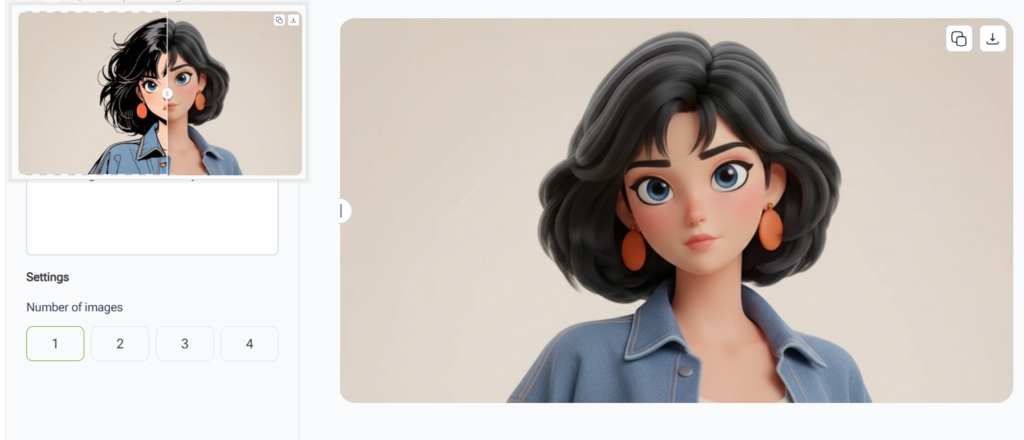
Step 4 – Export or Save Your Final Image
Download your image in PNG or JPEG. Some platforms, like VisualGPT, also support batch export for multiple versions.
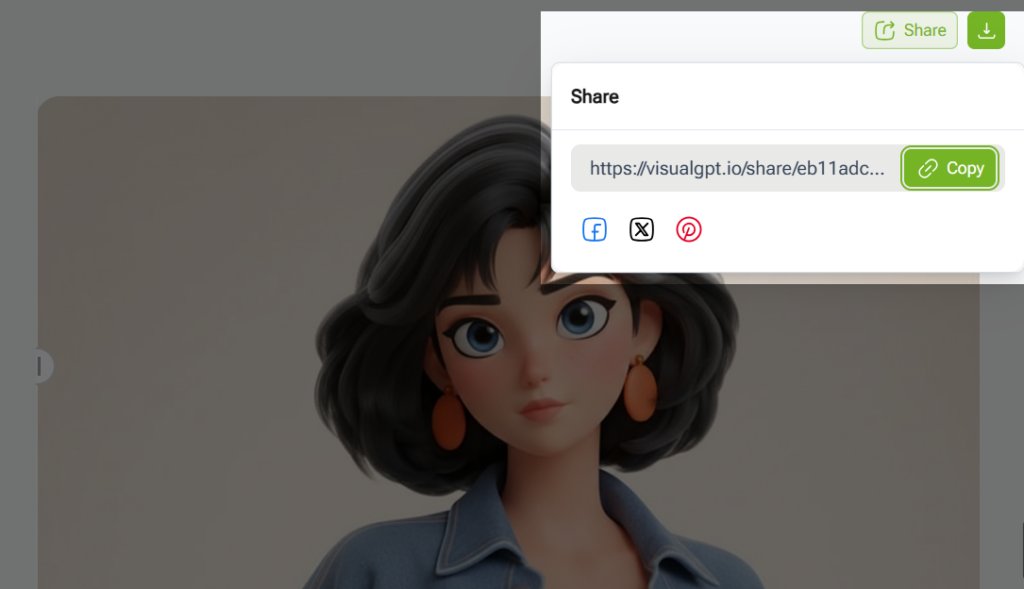
How to Use Nano Banana for Different Scenarios
Nano Banana isn’t just for fun edits—it’s practical across many industries.
Portrait Editing (Hair, Clothes, Background)
Want to try new hairstyles or outfits? Just tell Nano Banana. It can change a background from a bedroom to a professional studio while keeping your face natural.
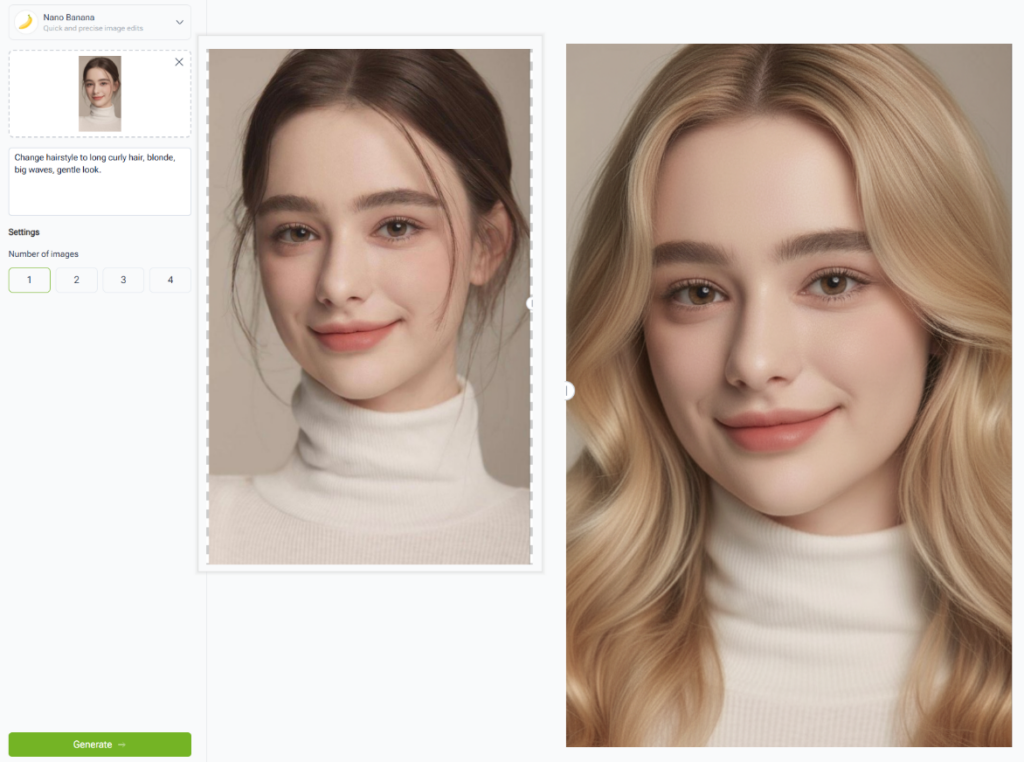
Product Images for E-Commerce
Online sellers can showcase one product in multiple colors, locations, or seasons. Instead of expensive reshoots, Nano Banana generates professional-looking variations instantly.
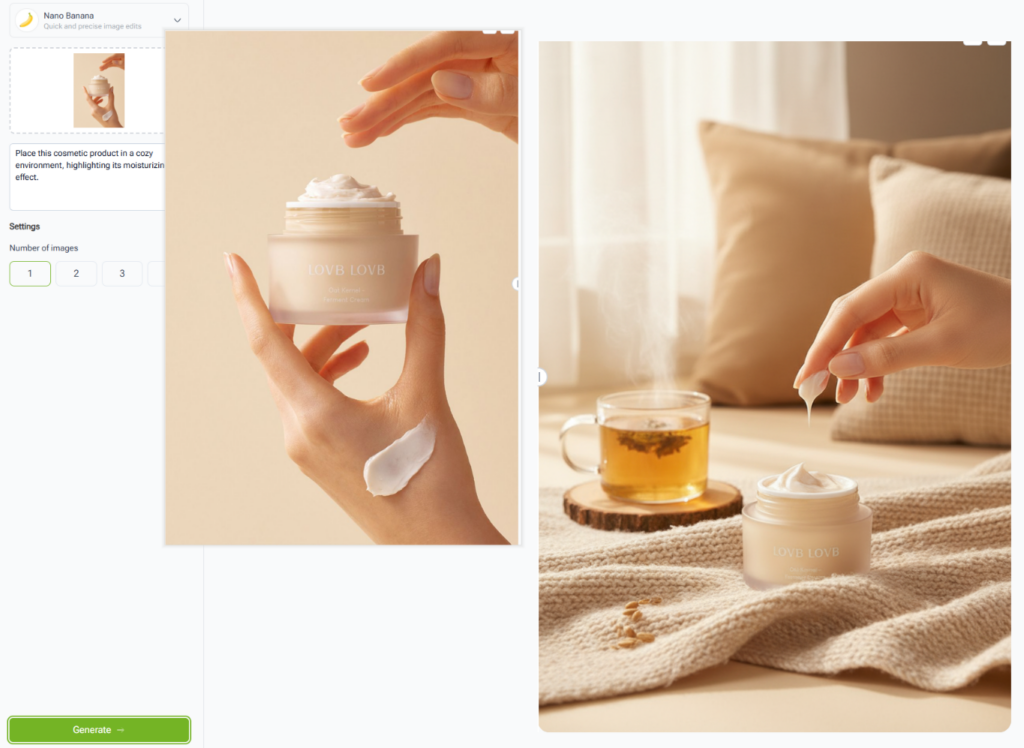
Social Media Content Creation
Content creators can generate eye-catching visuals in seconds—whether it’s a fantasy background for selfies, or stylized graphics for TikTok and Instagram.
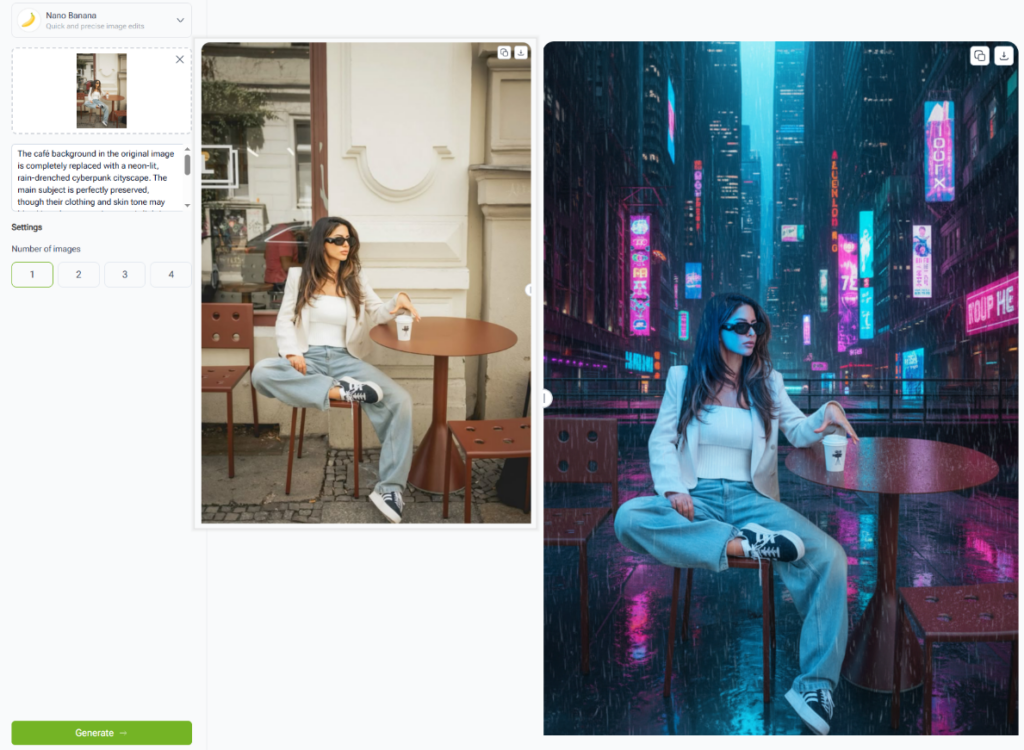
Artistic and Creative Styles
If you’re an artist, you can test different visual ideas quickly. Ask Nano Banana to turn a photo into an oil painting, a 3D render, or a futuristic landscape.
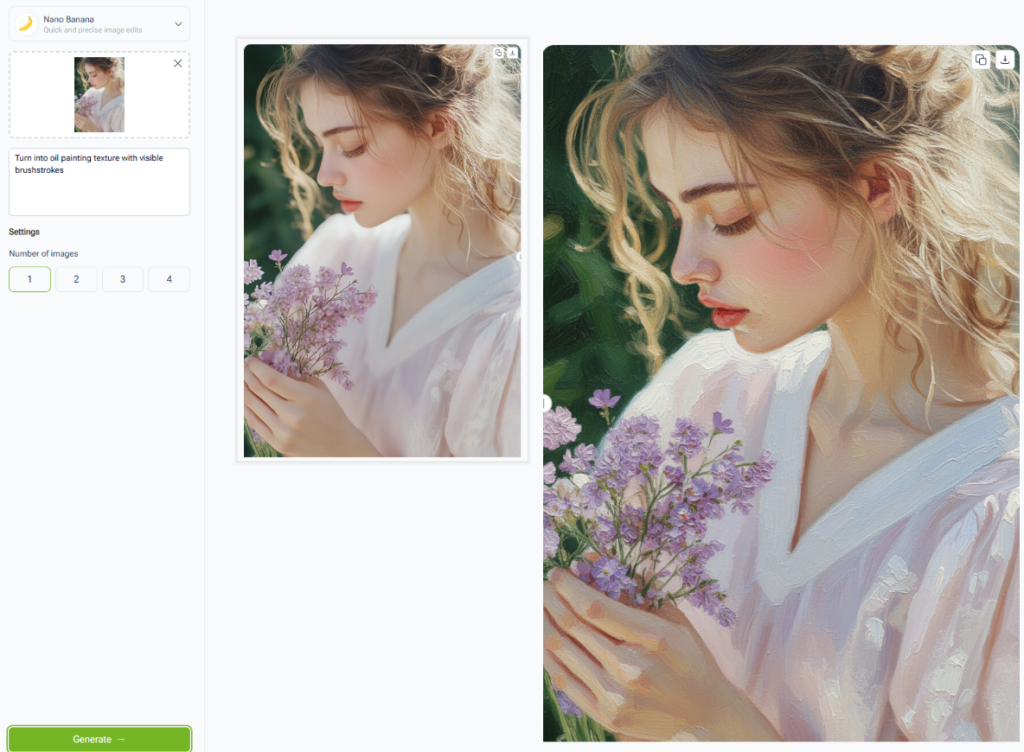
Marketing and Branding Materials
Marketers can instantly design ad creatives, banners, or campaign visuals. For example, you can place your product in multiple lifestyle settings to target different audiences.
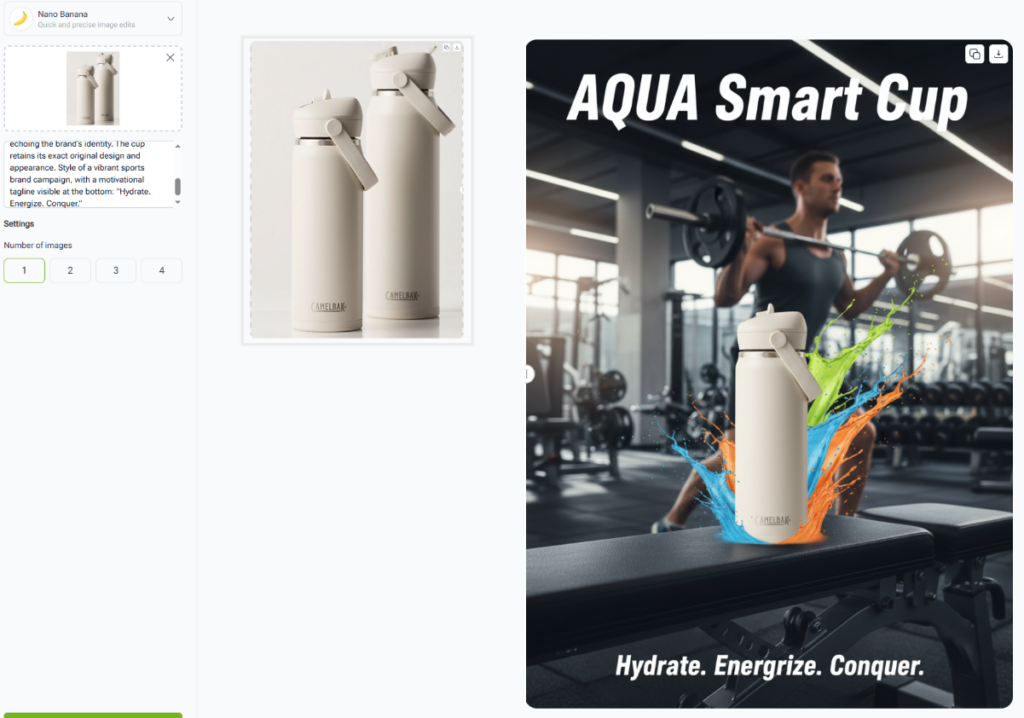
Educational and Presentation Use Cases
Teachers and students can use Nano Banana to visualize concepts. Imagine creating custom infographics or science illustrations without needing graphic design skills.
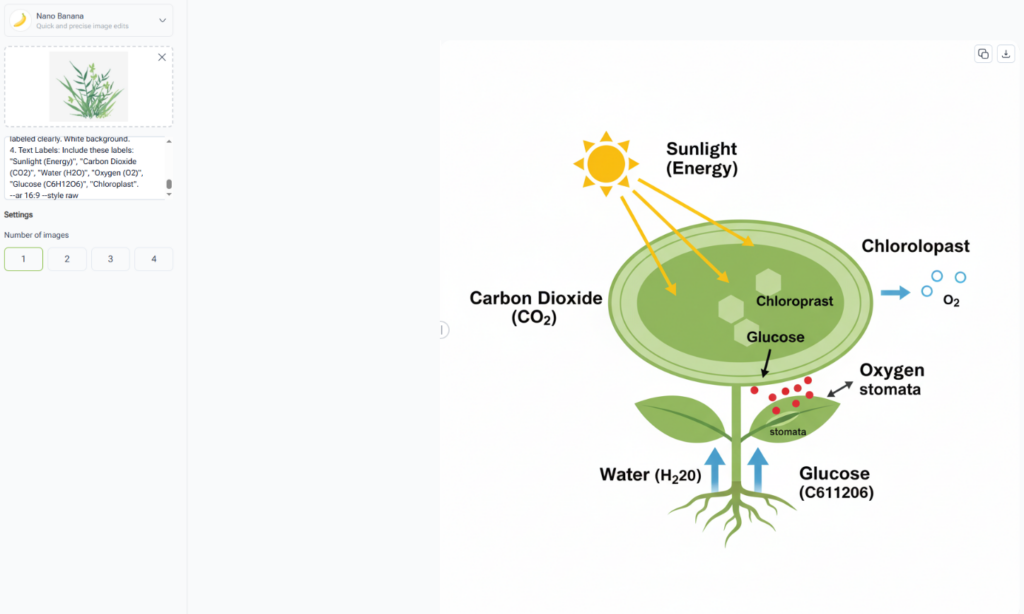
Best Practices and Tips for Using Nano Banana
Writing Effective Prompts
- Be specific: “Make the shirt navy blue” works better than “Change color.”
- Include style details: “Add a cyberpunk background with neon lights.”
- Use multi-step edits: Break down instructions into smaller steps.
Avoiding Common Mistakes
- Don’t overload one prompt with too many requests.
- Avoid vague words like “cool” or “nice.”
- Check resolution before exporting to ensure quality.
Optimizing Quality and Consistency
- Lock features you don’t want to change.
- Save seed numbers if you want reproducible edits.
- Compare variations to pick the most natural output.
FAQs on How to Use Nano Banana
1. What is Nano Banana?
Nano Banana is Google’s AI model for image generation and editing. If you want to learn how to use nano banana, it works like a smart design tool that turns text prompts into accurate, high-quality pictures or refined photo edits.
2. Is Nano Banana free?
Nano Banana costs around 1290 tokens per image, but you can try it free through platforms like VisualGPT. If you’re searching for how to use nano banana without paying, testing on third-party sites is the easiest way.
3. Do I need to sign up?
Yes, on Google AI Studio you need an account. But if you’re learning how to use nano banana fast, platforms such as VisualGPT allow instant image creation without sign-up, making the process much simpler.
4. Can I edit photos with Nano Banana?
Yes. If you’re exploring how to use nano banana for photo editing, you can upload an image and change backgrounds, colors, or small details using only text prompts, without replacing the entire picture.
5. How does it compare to MidJourney or DALL·E?
Nano Banana is better for precision and controlled edits. If you want to understand how to use nano banana effectively, it works best when you need consistent, realistic photo changes rather than artistic styles
6. Can I use Nano Banana for business?
Definitely. Knowing how to use nano banana for business helps with e-commerce, ads, and branding. It creates professional visuals quickly, saving both time and money for startups and established companies.
7. Does Nano Banana support batch editing?
Yes. If you are looking into how to use nano banana for bulk projects, you can generate many variations in one go, making it ideal for e-commerce stores that need multiple product images.
8. Do I need advanced skills?
No. Even beginners can learn how to use nano banana easily. You just type simple prompts like “change background to sunset” or “make the shirt blue,” and the model delivers instant results.
9. Can I save my work?
Yes. If you’re testing how to use nano banana for creative projects, you can export results in PNG or JPEG formats. Many platforms also offer storage options so you can reuse or edit later.
10. What devices support it?
Nano Banana is cloud-based, so you can explore how to use nano banana on desktop or mobile anytime. It works on computers, tablets, or phones, allowing quick edits or professional-quality design.
Conclusion: Why Learn How to Use Nano Banana in 2025
AI image editing has entered a new era. With Nano Banana, you no longer need professional software or years of training to create high-quality visuals. Whether you’re a student, marketer, designer, or casual creator, learning how to use Nano Banana opens the door to faster, smarter, and more creative image editing.
And thanks to platforms like VisualGPT, the technology is accessible to everyone. In 2025, knowing how to use Nano Banana isn’t just about fun edits—it’s about working smarter, saving time, and bringing your creative ideas to life.


